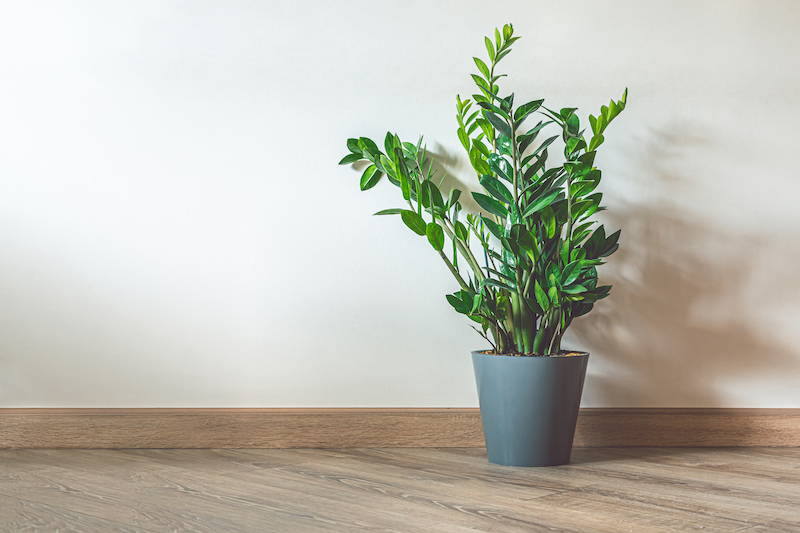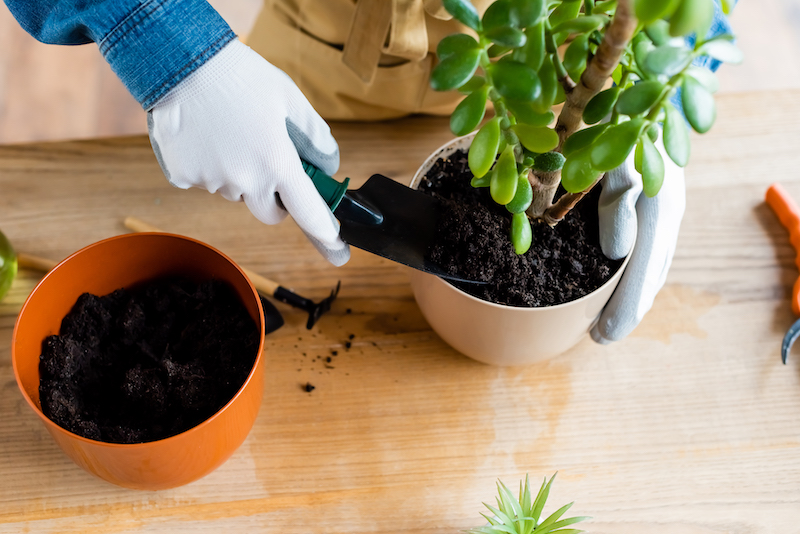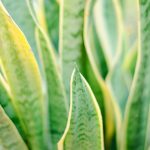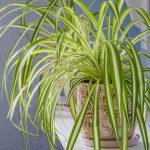For a stunning house plant, it’s difficult to go past a large ZZ plant, with its beautiful glossy foliage. And best of all, ZZ plant care is minimal. This makes it an ideal plant for beginners or more experienced indoor gardeners who may already have a jungle of indoor plants to care for. The ZZ plant, or Zanzibar Gem, is adaptable to various light levels and can tolerate drought conditions for a time. It doesn’t require regular fertilizing and is not fussy with the temperature and humidity of your indoor environment. It may not be one of the fastest growing plants in the list but it is easy to grow indoors and has the reputation of being a nearly indestructible house plant.

 |
 |
 |
 |
| Light | Water | Ease of Growing | Growth Rate |
| Adaptable to bright or low light Avoid direct sunlight | Allow to dry out in between watering | Very easy, great for beginners. | Slower, but long living |
There are not too many varieties of ZZ plant available on the market. Other than the original dark green ZZ plant, the Zanzibar Gem, there is one other variety with a dark maroon leaf called ‘Raven’ Zanzibar Gem. This is not so common and may require a bit of searching to track one down, and as expected is a little more expensive.
Although the ZZ plant is not a particularly fast growing house plant, when it does grow it adds a beautiful new stem with all the leaves in a short space of time. A new shoot appears from the ground and as you keep watching it, the new leaves can be seen curled around the stem. As the stem grows, the leaves unfurl and before you know it, your ZZ plant has created new growth before your eyes. In addition to this the ZZ plant is a long living house plant and given the right care will bring you joy for many years. It won’t outgrow the space you have for it too quickly so if the budget allows, you can purchase a larger plant to begin with.
Care Instructions For A Large ZZ Plant
Light
For a large ZZ plant to grow, it needs to be provided with a good amount of light. Early morning sun and bright, filtered light are ideal, but it does need to be protected from direct sun during the day. ZZ plants are adaptable to lower light conditions but their growth may be minimal in dim light.
Water
The best way to test if your ZZ plant needs watering is to feel the top 1″ – 2″ (2.5cm – 5cm) of soil. If the soil is moist, leave it a few more days before retesting. If the soil is dry, then the best way to water it is to give the pot a thorough soaking and be sure to allow the excess water to drain away.
Overwatering is more of a problem than underwatering for growing a large ZZ plant. If the soil is continually too moist, root rot is likely. ZZ plants are adapted to survive drought for short periods and during winter it is especially important not to overwater your plant.
Temperature and Humidity
The ZZ plant is an easy, hardy plant to grow, especially in terms of humidity and temperature. It does not have specific requirements and will happily grow in most humidity levels and temperatures between 60ºF – 79ºF (15ºC – 26ºC). Warmer temperatures are ideal to encourage the growth of a large ZZ plant.
Fertilizer
Another benefit of the ZZ plant is that it is not particularly needy in terms of fertilizer. If the plant is not growing, it does not need feeding. When it is growing, usually between spring and autumn, it can be fed with a half-strength dilution of liquid fertilizer, about once a month.
Pruning
Pruning your large ZZ plant is only necessary to remove any unsightly, yellowing leaves. Although if you are watering it correctly, this shouldn’t be a common occurrence.
Planting Guide For a Large ZZ Plant
Soil
The most important feature of the soil for a large ZZ plant is that it drains well, as soggy soil will promote the development of root rot. Ideally a cacti or succulent soil would be best.
Repotting
Your ZZ plant care is simple and you do not need to fuss over your plant. Repotting is only necessary if it outgrows its pot and is best done in spring or summer so it has time to settle in to its new pot when the temperatures are warmer.

Propagation
If you have a large ZZ plant that has outgrown its pot, when you repot it may be the ideal time to consider dividing the plant. This is done by dividing the rhizomes (underground stems). A large ZZ plant can be divided into multiple pieces as long as each piece has sufficient leaf growth to begin a new plant.
Another way to propagate a ZZ plant is to take a leaf off the stem, allow it to slightly dry out at the base and then place the base in some fresh potting mix. This is a slower process and can take several months to a year before any new growth can be seen above the soil. Don’t give up hope though because the rhizome will grow below the ground first and then the new shoots will poke up through the soil. During this time, keep the plant warm and the soil slightly damp, taking care not to overwater it. It may be tempting to place it in the sun but it is necessary to avoid direct sunlight too.
Common ZZ Plant Problems
ZZ plants generally have a natural resistance to pests so you shouldn’t have too many problems here, especially indoors. The most common problem people have is with getting the watering balance right.
Yellowing leaves and soft, mushy stems are generally an indicator that the plant has been overwatered. If this happens, allow it to dry out immediately. It is advisable to check the stems and if possible the roots, and remove any rotting plant material as this is not likely to recover.
If the plant gets too cold in winter it may occasionally develop yellow leaves that drop off. If a large ZZ plant is dropping more leaves than usual, check the soil moisture. It is possibly suffering from underwatering and will drop leaves as a way to try and conserve water loss. In this case, give the plant a thorough soaking and allow excess water to drain away.
Toxicity
ZZ plants are toxic to pets and people. They can cause skin irritation too so it is advisable to wash your hands after repotting them.
Summary Of ZZ Plant Care
Do:
- allow soil to dry out between waterings
- water thoroughly less often and ensure the soil and pot have good drainage
- patiently wait for new growth
Don’t:
- overwater it, especially in winter
Interesting Facts
- ZZ comes from the scientific name Zamioculcas zamifolia.
- Can put it under a tepid shower to wash the leaves if it gets too dusty – be sure to allow the excess water to drain.
- It will grow towards light so be sure to rotate it every now and then.
To encourage the growth of a large ZZ plant provide bright, filtered light, moderate watering and a warm place in your home. Given these conditions, a ZZ plant will thrive and reward you for your minimal efforts for years to come. You can enjoy the beauty of a large ZZ plant with minimal gardening experience and gain gardening confidence with this nearly indestructible house plant.






